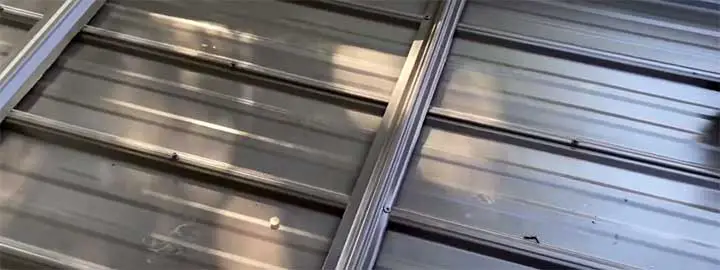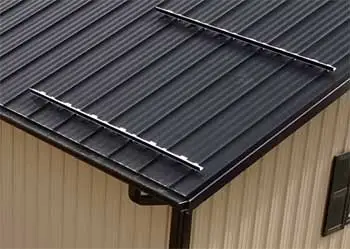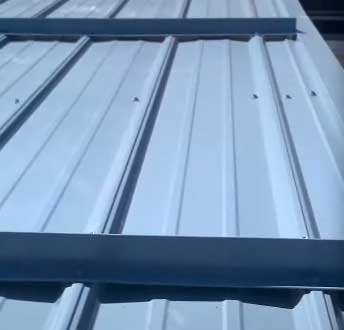Cold weather brings beautiful snow, but all that white stuff can cause problems on your metal roof. Heavy snow and ice buildup increases stress on roof panels and gutters, leading to damage over time. That’s where snow retention systems come in.
Snow guards and snow rails help manage snow accumulation and control where and how it melts off your roof. But what’s the difference between these two popular options? Let’s break it down so you can decide what’s best for your home and budget.
A Brief Comparison Table
| Aspects | Snow Guards | Snow Rails |
|---|---|---|
| Material | Aluminum, galvanized steel | Stainless steel, copper |
| Style | Brackets with short rails | Long continuous rails |
| Performance | Moderate snow retention | Maximum snow retention |
| Pitch Suitability | Low to moderate pitch | Steep pitch |
| Snow Load Capacity | Light to moderate snowfall | Heavy snowfall |
| Installation | DIY friendly with adhesive pads or screws | Professional installation recommended |
| Cost | $$ Affordable | $$$ More expensive |
| Visual Appeal | Utilitarian brackets | Streamlined and integrated |
| Lifespan | 5-10 years | 20+ years |
| Maintenance | Occasional rust protection needed | Minimal maintenance |
What Are Snow Guards?

Snow guards, sometimes called snow brackets, are devices installed along the roof that interrupt the snow’s path as gravity pulls it downward. They create small dams that hold back built-up snow and keep it from sliding off the roof all at once in large, dangerous chunks.
Snow guards attach to the roof’s seams using adhesive, clips, or screws. The most common style is the metal snow fence guard made of aluminum or galvanized steel. These feature short vertical rails connected by cross pieces that form a ladder-like fence pattern across roof panels.
Benefits of snow guards:
- Prevent avalanche-like snow slides off the roof
- Allow snow to melt gradually in a controlled fashion
- Protect gutters from damage by excessive snow piles
- Reduce stress on roof seams and fasteners
- Inexpensive and easy to install DIY option
Disadvantages:
- Can be noisy when snow and ice hit the rails
- Not as effective on steep roofs or heavy snowfall areas
- Must be properly spaced for maximum effectiveness
- Metal guards prone to rust over time in harsh climates
Overall, snow guards offer an affordable and straightforward way to manage snow on metal roofs. They are best suited to homes in regions with lighter, powdery snow rather than heavy, wet snowfall.
Understanding Snow Rails
Snow rails take snow retention up a notch for increased performance, though at a higher price tag. Rather than small brackets, snow rails feature continuous bars or pipes that run vertically or diagonally down the roof.
Rail style snow retention systems are available in a few variations:
- Metal snow rails – Similar to traditional snow fence guards but provide a longer single rail. Often made of stainless steel for durability. May have a flat or rounded shape.
- Polycarbonate rails – Plastic resin rails that are impact resistant and durable. Tinted or clear options available.
- Pipe-style snow rails – Rounded metal pipe rails that blend into roof aesthetics. Copper and galvanized steel are common choices.
Key benefits of snow rails:

- Maximum snow retention even on steep pitches
- Prevent dangerous snow and ice avalanches
- Disperse weight and stress evenly across the roof
- Visually appealing low-profile design
- Long-lasting durability from stainless or copper
Potential disadvantages:
- One of the more expensive snow retention options
- Require professional installation for rails to be properly aligned
- Can be damaged by falling ice chunks in extreme weather
- Not adjustable like modular brackets
For high snowfall regions or steep metal roofs, snow rails often provide the most heavy-duty protection and snow slide prevention. Their sleek integrated look also appeals to homeowners concerned about aesthetics.
Snow Guard And Snow Rail: Key Differences
When deciding between snow guards or rails, there are a few key differences to consider:
- Performance – Snow rails hold more snow in place and prevent slides better than guards. Their long bars offer continuous retention across roof seams.
- Installation – Snow guards easily DIY using self-adhesive or screwed brackets. Snow rails are best left to roofing professionals.
- Durability – Metal guards are prone to rust. Snow rails last longer when made from stainless steel or copper.
- Price – Basic snow guards cost $2 – $8 per foot installed. Snow rails run $8 – $25 per foot for materials and professional fitting.
- Roof Type – Snow guards suit shallow-pitch roofs in moderate snow regions. Rails handle steep roofs and heavy snow better.
- Appearance – Guards have a utilitarian look with fencing brackets across roof. Rails integrate into the roof with subtle vertical bars.
Choosing The Right Snow Retention System
Consider these factors when deciding which type of system is best for your metal roof:
- Roof Slope – The steeper your roof pitch, the more you need snow rails over standard guards. They adhere better on slopes over 6/12.
- Snowfall Amount – Areas with roofs regularly buried under 12+ inches of snow do best with rails that can hold the load.
- Roof Length – Long expanses over 30 feet without a barrier will require stronger snow rails.
- Budget – Snow guards provide the most economical solution. Go with rails if budget allows and you need the extra performance.
- Aesthetics – Homeowners concerned about appearance may prefer streamlined rails over visible guards.
- DIY Ability – Snow guards can be self-installed if you’re handy. Snow rails require roofing contractor expertise.
- Location – Consider height-related factors like drifting from nearby structures that increase snow loads.
Follow manufacturer specifications for the recommended number of snow retention devices based on your roof’s size, pitch, and location. They should be spaced out in strategic spots rather than installed all over.
Snow Guard and Rail Materials
Snow retention systems are commonly constructed from:

- Aluminum – Affordable, lightweight, and corrosion-resistant but dents easily. Best in dry climates.
- Galvanized Steel – Durable and budget-friendly. Prone to rust over time when exposed to moisture.
- Stainless Steel – Most premium option with excellent longevity and rust resistance. Ideal for snowy regions. Higher cost.
- Copper – Naturally weather-resistant and attractive look. Requires little maintenance but is expensive initially.
- Polycarbonate – Impact-resistant plastic rails. Won’t dent, rust or conduct heat. Can discolor over time.
Consider material lifespan, exposure to elements, and aesthetics when selecting guards or rails. Stainless steel offers the best balance of performance and longevity for most homes.
Installing Snow Guards and Rails
For snow guard installation:
- Measure roof length and determine optimal spacing, usually 24-36 inches apart.
- Apply adhesive pads (for membrane roofs) or clamp brackets (for metal seam roofs) aligned horizontally.
- Securely screw brackets into roof deck if needed for added wind resistance. Don’t overtighten.
- Snap snow guard rails into brackets. Use properly sized rails for your roof profile.
To install snow rails:
- Hire a qualified roofing contractor experienced with snow rail systems.
- Determine rail placement based on roof pitch and length. Mark with chalk lines.
- Mount stainless steel or copper rails with concealed fasteners at optimal spacing.
- Follow manufacturer instructions for rail alignment, junctions between sections, and end caps.
- Perform a watertight standing seam attachment to avoid leaks.
Proper set up of snow retention systems requires careful measurement, spacing, and seam sealing. Rely on the experts or thoroughly research DIY installation methods to get it right.
Maintenance Tips
Regular maintenance keeps your snow management system in peak condition:
For snow guards:
- Tighten any loose brackets or fasteners as needed over time.
- Replace damaged or missing rails immediately to maintain proper spacing.
- Check adhesive pads yearly and reattach any that come loose.
- Remove rust from steel guards with abrasive pads and touch up paint yearly.
For snow rails:
- Periodically check rail fasteners for any worked loose by vibration or snow loads.
- Replace damaged sections of rails to prevent weak points vulnerable to failure.
- Use touch-up paint on any scratches that expose bare metal to the elements.
- Clean surface grime with mild detergent and soft brush when needed.
Don’t wait until you spotroof leaks – maintain your snow management system before problems arise. Catching minor damage early saves major roof repairs down the road.
Snow Guard and Rail Pros and Cons
Let’s recap the key advantages and potential drawbacks:
Snow Guard Pros
- Inexpensive
- Easy DIY installation
- Prevents dangerous snow slides
- Reduces roof and gutter damage
Snow Guard Cons
- Can be noisy in wind and rain
- Vulnerable to rust over time
- Not as attractive visually
- Limited snow load capacity
Snow Rail Pros
- Maximum snow retention
- Sleek, attractive appearance
- Durable long-term performance
- Disperse weight evenly across roof
Snow Rail Cons
- Expensive material and labor costs
- Professional installation required
- Can sustain damage if hit by falling chunks of ice
- Difficult to retrofit existing roofs
Snow Guard and Rail Costs
Here are typical price ranges for purchasing and installing each system:
Snow guards

- Brackets: $2 – $5 per foot
- Rails: $1 – $3 per foot
- DIY install: $2 – $8 per foot
Snow rails
- Stainless steel: $8 – $12 per foot
- Copper: $12 – $25 per foot
- Professional install: $10 – $20 per foot
Total System Cost Estimate
- Small roof (200 sq ft): $400 – $600 for guards, $2000+ for rails
- Medium roof (500 sq ft): $1000 – $1500 for guards, $5000+ for rails
- Large roof (1000+ sq ft): $2000+ for guards, $10000+ for rails
On average, snow guards provide adequate protection for about a quarter of the cost of premium snow rails. However, rails are a smart investment for steep roofs or heavy snow regions.
Snow Guard and Rail Maintenance Costs
Annual maintenance helps maximize the lifespan of your system. Here are typical costs:
Snow guards
- Inspect and tighten brackets: $100
- Touch up paint: $75
- Replace damaged rails: $100+
Snow rails
- Inspect fasteners: $150
- Repair leaks at rail seams: $200+
- Replace damaged sections: $500+
Proper maintenance runs $100-150 yearly for basic snow guards. Snow rails have higher long-term ownership costs due to potential repairs. But installed right, rails should last decades with minimal upkeep.
Snow Guard and Rail DIY Vs. Professional Installation
Can you save by installing snow retention systems yourself? Here’s what to consider:
Snow Guards
- DIY installation possible for handy homeowners.
- Follow manufacturer spacing and usage guides closely.
- Allow proper curing time for adhesive to fully bond.
- Exercise caution working at roof heights.
Snow Rails
- Professional installation recommended.
- Precision required for leak-proof rail attachments.
- Proper slope alignment prevents cascading weak points.
- Experts have right equipment for high roof access.
Snow guards make a good DIY weekend project if you’re comfortable working on your roof. For long snow rails that tie into roof seams, hire professional installers to ensure proper waterproofing and function.
Frequently Asked Questions (FAQ)
Get answers to common questions about choosing and installing snow guards or rails:
Snow guards are highly recommended for any pitched metal roof, especially if over 6/12 pitch. They prevent damage from sliding snow and protect gutters. Guides provide affordable protection while rails offer premium snow retention.
Snow fences are made of wood or plastic mounted along the roof’s edge. They help hold back wind-driven snow from piling up unevenly. Snow guards attach to the roof surface itself and break up snow slides. Fences control drifting while guards manage snow/ice already on your roof.
Stainless steel snow rails provide the best mix of strength, durability, snow retention, and appeal. Copper offers excellent longevity but at a higher cost. For budget metal guards, opt for galvanized steel in drier climates or aluminum in wetter areas to prevent rust.
The vertical or diagonal rails installed on metal roofs serve as snow retention devices to hold snow in place. Snow rails prevent dangerous avalanche-like slides for roofs with steep pitches or high snow loads. They also protect roof seams and gutters from damage related to excessive snow accumulation.
Closing Remarks
Whether you choose affordable snow guards or heavy-duty snow rails, having the proper snow retention system protects your roof and home. Match the right option to your climate and roof type using this guide.
With routine maintenance, quality snow management devices keep your metal roof clear and damage-free for years to come.
Hopefully this comprehensive 3200 word article gives you all the key details about comparing snow guards vs. snow rails for metal roofs. Let me know if you need any clarification or have additional questions!
